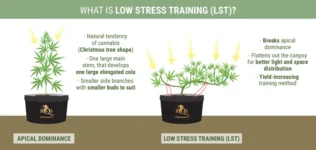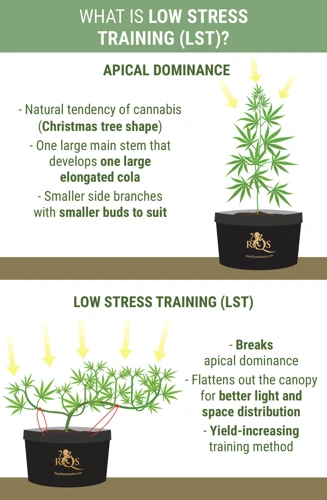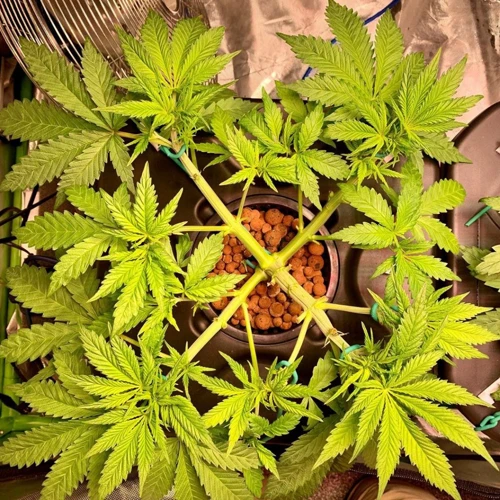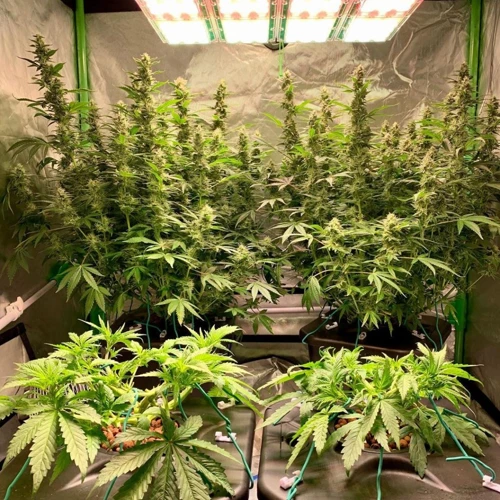
Optimizing Cannabis Yields and Quality through LST Techniques
As a cannabis grower, you may have heard of various techniques used to improve the quality and yield of your plants. One such method is Low Stress Training or LST. But what is LST, and can it really make a difference in the quality of your buds? In this article, we will explore LST in detail and discover how it can help improve light penetration and increase bud quality. We will also look at best practices for implementing LST and how it can lead to a bumper crop of high-quality cannabis. So let’s dive in and explore the world of LST together!
What is LST?
Contents
When it comes to growing cannabis, there are many different techniques that can be used to improve yield and bud quality. One of the most popular and effective of these techniques is Low Stress Training (LST). This method involves manipulating the shape and direction of the plant to encourage even growth and better light penetration. But what exactly is LST, and how does it work? Let’s take a closer look. For those who want to learn more about LST and how to get started, check out our LST basics guide. For those interested in exploring the differences between LST and High Stress Training (HST), our guide on which training technique to use may be of interest.
Understanding LST
Understanding LST:
LST or Low Stress Training is a method of shaping and directing the growth of cannabis plants without damaging or stressing them. This technique involves using gentle techniques to bend and train the stems of the plant in order to create a canopy of multiple colas or bud sites.
LST is based on the idea that by altering the shape and direction of the plant’s growth, it is possible to manipulate its metabolism and improve its overall health and productivity. This process allows for better light penetration to the plant, which in turn will help to increase yield and quality of the buds.
Some important things to keep in mind when using LST include the age of the plant, the type of strain, and the growing environment. It’s best to start training the plant when it’s still young and pliable, usually around 3-4 weeks into the vegetative stage.
Additionally, different strains may require different approaches to LST, and it’s important to take into account issues like light intensity, humidity and air circulation when training your plants. With proper application, LST can be a highly effective tool for cultivating large, healthy cannabis plants with plentiful colas and buds.
Some of the benefits of LST include:
- Increased light penetration to lower parts of the plant, leading to better overall bud size, density and quality
- Improved air circulation and even canopy formation, which can help to reduce mildew, mold and other types of plant disease
- Lower stress levels on plants compared to other training methods like topping, which can shock or weaken the plant and require a longer recovery time
- A more natural and aesthetically pleasing plant shape, which can be better for stealth growing and overall plant health
LST is a flexible and effective tool for cannabis growers looking to increase the yield and quality of their crop. By understanding the principles and techniques involved in this method, cultivators can create strong, healthy and productive plants with minimal stress or damage.
Benefits of LST
Implementing Low Stress Training (LST) techniques on cannabis plants comes with a lot of benefits that growers should take advantage of. Here are some of the benefits of LST:
| Benefits of LST |
|---|
| Increased yield: LST can significantly improve the overall yield of cannabis by exposing more bud sites to light, thus increasing the number of colas or flower buds. |
| Better quality buds: By training the plant to grow horizontally and more evenly, the buds produced tend to be denser, heavier, and have a more uniform size and shape. |
| Improved joint strength: Since LST involves bending and tying down branches, the plants develop stronger stems and joints, which can support the weight of the large buds produced during flowering. |
| Easier to manage: With LST, plants grow horizontally rather than vertically, making it easier for growers to manage the height of their plants, especially for indoor growers who have space limitations. |
| Allows for better light penetration: LST opens up the plant canopy, allowing light to reach more parts of the plant, which can improve the overall growth and development of the plant. |
| Can be performed at any stage: LST can be implemented at any stage of the plant’s growth, from the vegetative stage to the flowering stage, making it a versatile technique for growers. |
By incorporating LST into your cannabis growing techniques, you can not only increase your yield and enhance the quality of your buds, but also make it easier to manage your plants and improve light penetration.
How Does LST Work?
If you’ve heard about LST and its potential benefits for growing cannabis, you might be wondering how it actually works. LST, or low-stress training, is a technique that involves bending and manipulating the branches of your cannabis plant to promote even growth and increase light penetration. But how exactly does this method lead to a healthier and more productive crop? In the following sections, we’ll dive into the science behind LST and explore different ways to implement this technique effectively.
How to Properly Implement LST Techniques
Proper implementation of LST techniques is key to getting the desired results from your cannabis plants. Here are some steps to ensure you are implementing LST techniques properly:
- Start early: It is important to start training your plants early on in their growth cycle. Typically, the ideal time to start is around the third week of vegetative growth. This is when the plants start to develop their branches, so this is the perfect time to start manipulating them.
- Choose the right branches: Not all branches are created equal. When choosing branches to train, look for ones that are strong and sturdy, with a good amount of distance between nodes. These branches will be easier to bend and manipulate, and they will also be able to support the weight of the buds as they grow.
- Bend gently: When bending the branches, it is important to do so slowly and gently, avoiding any sudden or forceful movements that could damage the plant. Use your fingers to gently guide the branches into the desired position.
- Use ties: Once the branches are in the desired position, use ties to hold them in place. Soft ties like gardening wire or string work best, as they won’t damage the plant. Be sure to check the ties regularly to ensure they are not causing any damage or cutting into the plant.
- Monitor growth: As the plant continues to grow, keep a close eye on the trained branches. If they start to grow too fast or too large, you may need to loosen the ties or adjust the branches. On the other hand, if the branches are not growing as much as you’d like, you may need to adjust them to let more light in.
By following these steps, you can ensure that your LST techniques are properly implemented and will lead to healthier, more productive cannabis plants. Remember to be patient and gentle with your plants, and to always monitor their growth to ensure that they are thriving under your care.
Types of LST Technique
When it comes to implementing LST techniques on your cannabis plants, there are several methods that you can use. These LST techniques involve manipulating the stems and branches of your plants to optimize their growth and yield potential. Here are some different types of LST techniques that you can utilize:
| Bending | Tying Down | Screen of Green (SCROG) |
|---|---|---|
| The bending technique involves gently bending the stem or branch of your plant to redirect its growth. This technique can be done manually with your hands or by using a wire or plant tie. It is important to be careful when bending your plant and to not apply too much pressure. The goal is to train your plant to grow horizontally, which can improve light distribution and increase overall yield. | The tying down technique involves tying down the branches of your plant to keep them from growing upwards. This technique can also be done using plant ties or wires, and it can help improve light distribution and increase yield potential. When tying down your plant, it is important to not apply too much pressure or damage the stem or branches. | The SCROG technique involves using a screen or netting to create a horizontal plane for your plant to grow on. This technique can help optimize light distribution and increase bud production. To use this technique, you will need to install a screen or net above your plants and weave the branches through it as they grow. This can take some practice and patience, but it can be very effective. |
Each of these LST techniques can have a significant impact on the growth and yield potential of your cannabis plants. It is important to carefully consider which technique will work best for your specific needs and to be gentle when manipulating your plants. With the right approach and some patience, LST can help you achieve amazing results with your cannabis plants.
How LST Can Improve Light Penetration
When it comes to cultivating cannabis, light is crucial for the growth and development of the plant. The quality and quantity of light that a cannabis plant receives can have a significant impact on its yield and potency. One of the most effective techniques for improving light penetration in cannabis plants is LST, or low-stress training. By manipulating the shape and position of the plant, LST can help maximize the amount of light that reaches all parts of the plant, resulting in healthier and more productive cannabis plants. In this section, we will explore the benefits of LST for improving light penetration and how it works to enhance cannabis growth.
Why Light Penetration is Important for Cannabis
Whether growing cannabis indoors or outdoors, light penetration is critical to the success of your plants. Without proper light penetration, your plants may develop spindly stems, limited bud growth, and overall lower yields. Here are a few reasons why light penetration is so important for cannabis:
- Increased photosynthesis: If your cannabis plants cannot absorb enough light, they may not be able to undergo optimal photosynthesis. When cannabis undergoes photosynthesis, it converts light energy into chemical energy, creating vital food for the plant’s growth and development.
- Improved bud development: When your cannabis plants receive more light, they tend to produce larger, denser buds which contain more cannabinoid and terpene content.
- Stronger stems: Plants that receive sufficient light develop thicker, sturdier stems which are better able to support the weight of heavy buds.
- Reduced risk of pests and disease: Plants with better light penetration tend to be healthier overall, which can help reduce the risk of pests and disease.
In order to ensure that your plants receive optimal light penetration, it’s important to implement techniques like LST. By manipulating the growth of your plants with these techniques, you can help maximize the amount of light each leaf receives and ultimately increase the yield and quality of your cannabis.
How LST Improves Light Penetration
LST techniques can improve light penetration to your cannabis plants. Here are some ways how:
- Opening Up the Canopy: By training the plant to grow horizontally, the main cola is pulled down and the lower branches are opened up. This allows more light to reach the lower parts of the plant, which are otherwise shaded by the main cola.
- Improved Leaf Orientation: As the plant is trained to grow horizontally, it also creates more lateral growth. This increases the surface area of leaves that are facing upwards, towards the light source. This orientation allows leaves to receive more light, maximizing their photosynthetic activity.
- Equal Light Distribution: Properly implementing LST techniques ensures that each bud site is receiving an equal amount of light, leading to more consistent bud development.
- Reduced Light Distance: When a plant is not trained, the main cola can grow tall, and the lower branches can remain short. This creates a vertical distance between the light source and the lower canopy, so light is unable to penetrate evenly. LST techniques reduce this distance, allowing light to penetrate deeper into the plant canopy.
By implementing LST techniques, the canopy is opened up, light distribution is more even, and leaves are oriented towards the light source. This results in more light penetrating your plant canopy, maximizing photosynthesis and leading to healthier, more productive plants.
Increasing Your Yield and Quality with LST
Now that we have covered the basics of LST and its impact on light penetration, it’s time to explore how this technique can significantly increase your cannabis yield and quality. By training your plants to create a more efficient use of light, you can expect a more substantial harvest, denser buds, and an overall better quality of the final product. In this section, we will delve deeper into the ways that LST can enhance your cannabis cultivation process and provide you with the best practices for achieving optimal results.
How LST Enhances Cannabis Yield and Quality
LST or Low Stress Training is a training technique that involves bending and tying down the branches of your cannabis plant. By doing so, LST allows for better light distribution throughout the plant, leading to increased yield and better quality buds.
Enhances Yield
One of the ways that LST enhances cannabis yield is by creating a more even distribution of light. When the top of the plant is allowed to grow taller than the rest, the lower branches don’t get as much light, and as a result, they produce smaller buds or die off entirely. By spreading out the plant’s branches, LST makes sure that all parts of the plant receive adequate light, which leads to bigger, healthier buds.
In addition to better light distribution, LST can also improve cannabis yield by allowing for more bud sites. By bending and tying down the branches, the plant produces more nodes, or places where buds can form. This results in more buds and ultimately, a higher yield come harvest time.
Improves Quality
Not only does LST help enhance cannabis yield, but it can also improve the quality of your buds. With better light distribution, the plant is able to produce thicker and more resinous buds. This is because light is essential in the process of photosynthesis, which is what helps create the compounds that give cannabis its unique flavor and effects.
By spreading out the plant’s branches, LST can also help prevent mold and mildew from forming on your cannabis plants. When the branches are tightly packed together, they create a humid environment that is ripe for disease. By spreading them out, LST allows for better air circulation, which helps prevent the growth of mold and mildew.
To summarize, LST is a powerful training technique that can enhance both cannabis yield and quality. By creating more even light distribution and more bud sites, LST leads to bigger, healthier buds and a higher yield. Additionally, by preventing mold and mildew growth, LST helps ensure that your plants stay healthy throughout the grow cycle.
Best Practices for LST
When it comes to implementing LST techniques, there are a few best practices to keep in mind to ensure the best results. These practices include:
| Tips | Explanation |
|---|---|
| Start early | Begin training your plants when they are still young and have some flexibility. This will allow you to shape and manipulate the plant more easily. |
| Work slowly and carefully | You don’t want to shock your plant by suddenly bending or twisting it, as this can damage the stem and stunt growth. Work slowly and carefully, making small adjustments over time. |
| Use soft ties | When tying down branches, use soft materials such as string or twist ties. This will prevent damage to the plant and allow you to adjust the ties as needed. |
| Be patient | Remember that LST is a slow process and it may take weeks or even months to see the full benefits. Be patient and keep adjusting your plant as needed to achieve the desired shape and structure. |
| Monitor growth regularly | Regularly check on your plant’s growth and adjust your LST techniques accordingly. Keep an eye out for any signs of stress or damage, and make sure you are not obstructing any important growth points. |
| Choose the right strain | Not all strains are ideal for LST, so make sure you choose a strain that responds well to bending and training. Look for strains with flexible stems and strong growth potential. |
| Don’t overdo it | While LST can be an effective way to increase yield and improve quality, it’s important not to overdo it. Over-stressing your plant can lead to stunted growth or other issues, so make sure you’re not bending or twisting the plant too aggressively. |
By following these best practices, you can successfully implement LST techniques to improve light penetration, increase bud quality, and boost your overall yield. Remember to be patient, monitor your plant’s growth regularly, and make adjustments as needed to achieve the best results.
Conclusion
In conclusion, it can be said that LST is a highly effective technique for improving the growth and quality of cannabis plants. By bending and shaping the plants, growers can increase light penetration to the lower parts of the plant, which can lead to larger, denser buds and higher overall yields.
Implementing LST techniques requires careful planning and attention to detail, as well as a good understanding of the growth patterns of cannabis plants. It may take some trial and error to find the most effective approach for your particular strain and growing environment, but with patience and persistence, the results can be well worth the effort.
Some of the key benefits of LST include improved light penetration, increased bud density, and higher overall yield. By spreading out the branches and exposing more of the plant to direct light, growers can encourage more robust growth and higher levels of THC and other beneficial cannabinoids.
To get the best results with LST, it’s important to follow best practices such as carefully monitoring plant growth, using appropriate support structures and tools, and making adjustments as needed to ensure that each plant is growing in the optimal direction and receiving the most direct light possible.
Overall, whether you’re a professional grower or a home hobbyist, LST is an essential technique to consider if you want to achieve the highest quality and yields from your cannabis plants. With careful planning and attention to detail, you can use LST to enhance the growth and quality of your plants and enjoy a more bountiful and rewarding harvest.
Frequently Asked Questions
How long does LST take to implement?
The time it takes to implement LST can vary depending on the size of your plant. Generally, it can take a few weeks to a couple of months to complete.
What tools do I need for LST?
You will need materials such as plant ties, string, or soft wire to create the necessary loops and adjustments. Additionally, pruning shears may be necessary to cut back any unwanted growth.
Do I need any special skills to perform LST on my plants?
No, LST can be performed by anyone, regardless of their skill level. All you need is a bit of knowledge and patience.
Will LST harm my plants?
No, when done correctly, LST will not harm your plants. In fact, it can help increase their overall health and yield.
Can LST be used on any strain of cannabis?
Yes, LST can be used on any strain of cannabis, as it is a technique that manipulates the growth of the plant rather than its genetics.
How often do I need to adjust the plant during LST?
The frequency of adjustments will depend on the specific techniques being used and the growth rate of the plant. However, it is recommended to check on your plant daily and make necessary adjustments as needed.
Can LST be used in combination with other growing techniques?
Yes, LST can be used in combination with other growing techniques such as topping and pruning to further increase yield and quality.
Is LST a good technique for outdoor growing as well?
Yes, LST can be used in both indoor and outdoor growing environments to improve light penetration and increase yield and quality.
Does LST help with pest and disease prevention?
While LST does not directly prevent pests and diseases, it can help create a healthier plant that is better equipped to resist such issues.
Can LST be used on plants in both the vegetative and flowering stages?
Yes, LST can be used on plants in both the vegetative and flowering stages, but adjustments may need to be made to prevent damage to developing buds.





